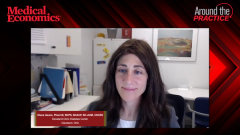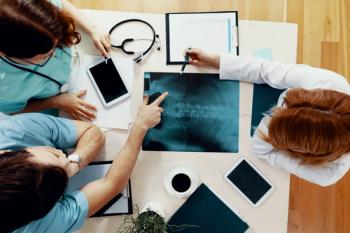
Case Study: Insulin Pump for Patient With T2DM
Diana Isaacs, PharmD, BCPS, BCACP, BC-ADM, CDCES, presents a case study of a patient with type 2 diabetes mellitus, an insulin pump, and a continuous glucose monitor.
Episodes in this series

Transcript:
Dhiren Patel, PharmD, CDE, BC-ADM, BCACP: I think what also is helpful and makes it real is seeing how you’ve put all of this that we’ve talked about today into practice. Dr Isaacs, I would love for you to walk us through a patient case. I know this is a patient case of yours, in which KC is a 76-year-old woman with type 2 diabetes. Provide us a little background on KC and then what you did with the patient. Obviously, not everything was done on the first visit, but walk us through where you picked this patient up and how you thought about it and how you were able to introduce diabetes technology for KC.
Diana Isaacs, PharmD, BCPS, BCACP, BC-ADM, CDCES: Yes. She’s a patient who has type 2 diabetes, who was using multiple daily injections of insulin. I introduced the options for her about continuous glucose monitoring and an insulin pump, and subsequently, she opted to start the Omnipod [system] with the Dexcom G6. We trained her, and the training was done virtually as well. That’s something we’ve been able to do, either in person or virtual training. However, I have been working with her, checking in with her, doing virtual appointments each week to continue to tweak the settings because I think when you start someone off from injections to a pump, you want to be conservative. You’d rather them running a little bit higher versus causing all this hypoglycemia. Thus, we started off a little more conservative and tried to home in on everything.
In this most recent report, she’s up to 60% time-in-target range, which is certainly getting closer to our goal of 70%. One of the things we figured out was that now she’s getting 68% of her insulin as basal, and typically we do try for more of a balance, closer to 50/50. It will depend a little on other agents and what the person is eating and everything. She is a little basal heavy, and we noticed that she was having some excursions after eating.
There was one unexplained one where she went up to like 400 [mg/dL], and this is where you have to talk to your patient, not just look at the report because it looked like, oh, she just didn’t bolus, right? But in talking to her, she said she went to a restaurant. She predicted, based on what she was eating, it was 35 g of carbohydrates. However, what we figured out probably happened was, we think her Diet Coke got substituted for a regular Coke because she bolused, she pre-bolused, and she still had this major excursion. Anyway, that was one example. But we did figure that probably her carb ratios needed to be tweaked a little, and so we did intensify those. Another thing we did was we reduced her glucose target because we figured she wasn’t getting enough correction insulin to bring her down when she was going high. Thus, we made those little changes and then we continued to work together, we will continue to do so until she hopefully gets to that 70% or beyond.
Dhiren Patel, PharmD, CDE, BC-ADM, BCACP: Excellent. I always say to the patients the data don’t lie. Hence, it’s helpful to have those conversations, otherwise you wouldn’t have figured out that specific excursion. Dr Busch, what have some of your experiences been as you see patients coming back? Here was a patient case of KC, and obviously that time in range is excellent. What has your experience been as these patients are on insulin pumps and CGMs [continuous glucose monitors]?
Robert Busch, MD: They’re getting their report card. They could see their time in range and know their A1c [HbA2c glycated hemoglobin] even before they come back in, so it’s great positive feedback for the patient. They feel better, they’re not getting hypoglycemic, they can see that they’re in range and they have much better control of things. Own your diabetes. They are owning it. It’s not just every 3 months when they come and get a pat on the back, they can get the pat on the back every day from their own monitoring.
Dhiren Patel, PharmD, CDE, BC-ADM, BCACP: Yes, absolutely. With that, I’d love any closing sound bites that each of you have as we think about diabetes technology. Today, we reviewed 3 of your big pillars, and there’s additional technology that’s still being introduced. We talked a little about continuous glucose monitors, insulin pens, as well as connected and smart insulin pens. Dr Isaacs, can we get some closing remarks from you on where we are from a diabetes technology standpoint?
Diana Isaacs, PharmD, BCPS, BCACP, BC-ADM, CDCES: Yes, we’re evolving. The whole point of this is it’s supposed to make everyone’s lives easier in terms of seeing what’s happening, making it easier for patients to be able to dose, to give themselves insulin. What I would encourage everyone to do is to attend programs like this. Try to stay up to date on what’s out there, so you can give your patients these options, so they know they have a choice. They don’t just have to use a regular insulin pen. They don’t have to use a regular glucose meter. They have all these options out there, and so they can make an informed choice and have the best quality of life they possibly can.
Dhiren Patel, PharmD, CDE, BC-ADM, BCACP: Absolutely. Dr Busch?
Robert Busch, MD: I agree. We have terrific drugs available, but also these other monitoring technologies and everything Dr Isaacs talked about. It’s a fun time to practice diabetes as well. As you highlighted, if you have to have diabetes, this is the best time to have it versus what we had years ago. If we look back, and many of us in our careers have looked back, to think that we practiced with NPH [neutral protamine hagedorn], and regular insulin, and urine dipsticks, and we thought we were doing a good job then. Back then, we thought if we divorced the R [Humulin R insulin] from N [Humulin N insulin] at dinner and gave the N at bedtime as the basal. Going from there to the vast array of medications we have now—it’s pretty incredible. That’s why endocrinologists and anyone doing diabetology will always work because it’s too much fun. That’s our hobby, and we can’t wait for the new thing to come out.
Dhiren Patel, PharmD, CDE, BC-ADM, BCACP: Absolutely. This has been an excellent discussion, and we hope you all found this information valuable. Thank you all for watching this Medical Economics® Around the Practice program. Thank you both.
Transcript edited for clarity
Newsletter
Stay informed and empowered with Medical Economics enewsletter, delivering expert insights, financial strategies, practice management tips and technology trends — tailored for today’s physicians.








